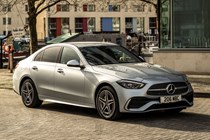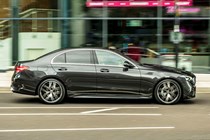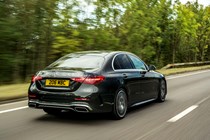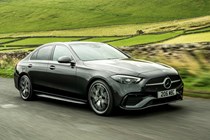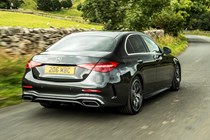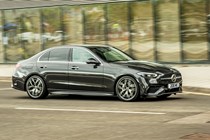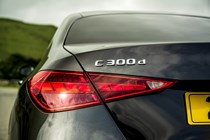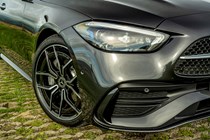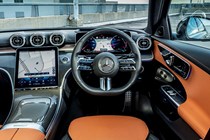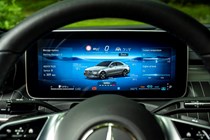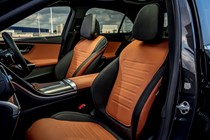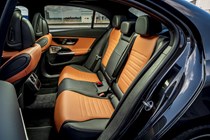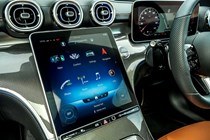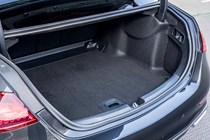
Mercedes-Benz C-Class engines, drive and performance
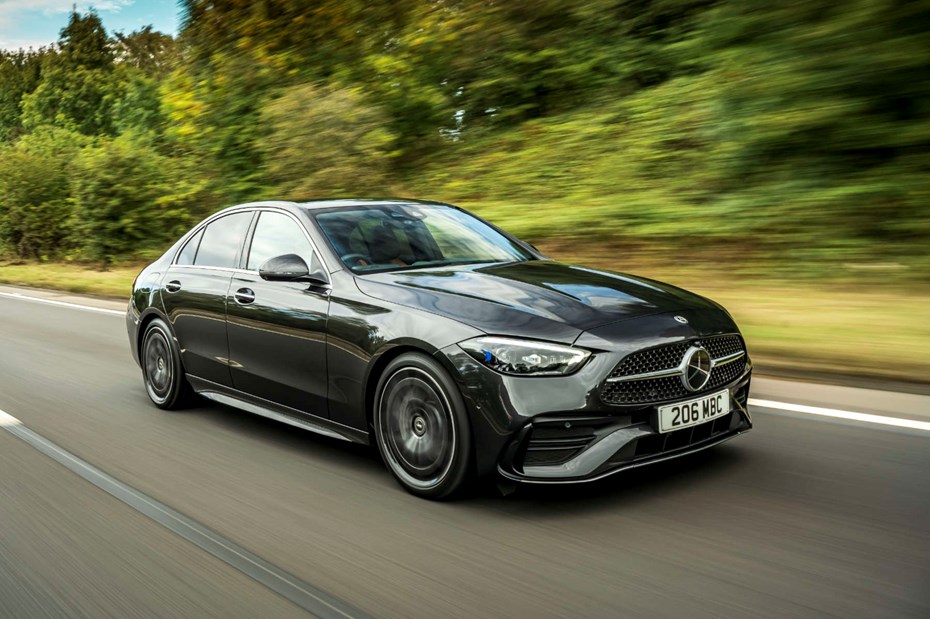
- Plug-in hybrid model is quick
- Diesel engines are sprightly enough
- AMG options for thrill-seekers
Petrol engines
The standard Mercedes C-Class is offered with a choice of two petrol engines, both of which are paired with a nine-speed automatic gearbox and a mild hybrid system. The cheapest 1.5-litre C200 should be enough for most buyers, serving up 204hp, 300Nm of torque and a 0–62mph time of 7.3 seconds.
You don’t need to work the engine hard to get it to shift along smartly and, when cruising on the motorway, it settles down to hushed cruise. It also never feels underpowered, even though it’s the most affordable option in the C-Class line-up.
The 2.0-litre C300 is a nice bridge between the standard C-Class and the full-fat fire-breathing AMG variants. It produces 258hp and 400Nm of torque, which is enough to slash the saloon’s 0–62mph time down to 6.0 seconds. It also has far more punch in the mid-range, which makes it feel far quicker.

Diesel engines
The 2.0-litre four-cylinder diesel unit fitted to the C220d feels almost perfectly suited to the C-Class’s character. It produces 200hp and a meaty 440Nm of torque, all of which is available from just 1,800rpm. That makes it an ideal motorway companion. Simply pick your overtaking victim, flex your big toe and you’re four car lengths away.
The C300d is even better at this party trick. It produces 265hp and an impressive 550Nm of torque, giving it some serious licence-losing potential. The 0–62mph sprint is dispatched in just 5.7 seconds, which is enough to trouble a lot of hot hatchbacks. Despite this, we can’t help but feel most owners would be better served by the C220d for its cheaper price and better fuel economy.
Plug-in hybrid engines
The C300e is a good choice for those locked in emissions-controlled areas. Its battery pack can store enough energy for a maximum range of 68 miles on electric power alone while its electric motor produces 127hp, which is more than enough to push the C-Class around at sensible speeds.
With CO2 emissions from just 14g/km, it’s also in the 8% company car tax bracket, which is some 4% below the BMW 330e. That means good things for economy even on a long run, although you’ll have to run on volts for most of your journeys to match the official economy figure of 565mpg.
Thankfully, that’s made easier by the C300e’s ability to charge at up to 55kW from a DC rapid charger. At those speeds, a 100% charge takes just 30 minutes. The battery can also charge at up to 11kW from a more readily available AC charger.
The C300e is surprisingly fast when its 2.0-petrol engine and electric motor work in tandem. Together, they produce 313hp and 550Nm of torque – so it’s a bit of a Q-car on the motorway. The 0–62mph time is respectable at 6.1 seconds. In fact, our only real complaint is that the petrol engine is quite boomy when you accelerate hard, punctuating the calm that preceded the accelerator pedal being mashed to the floor.
What’s it like to drive?
- Firm suspension
- Not as sharp as the BMW 3 Series…
- … but objectively pretty good
Traditionally, non-AMG versions of the Mercedes C-Class focused on comfort rather than sportiness, but the brand mixed things up for the latest generation model. On twisty roads, it performs admirably. The steering is well-weighted and the chassis is reasonably balanced. However, it’s not as sharp or agile as a BMW 3 Series, with noticeably less grip up front and more body roll.
There’s a trade-off to this new-found cornering ability, though. It’s less comfortable than its predecessor, especially on Mercedes’s larger 19-inch alloy wheels. It doesn’t deal well with speed bumps and passing over rough tarmac at low speeds will toss you around in your seat. Potholes generate a bit of a thump, too.
However, all these issues smooth out once you get to higher speeds. The chassis is at its best on the motorway, smoothing out longer dips and crests very well indeed. It’s stable, too. Even in crosswinds, it sticks to its lane like a limpet. Mercedes’s lane-keeping assist system is a little intrusive, but you can easily switch that off on the infotainment system.
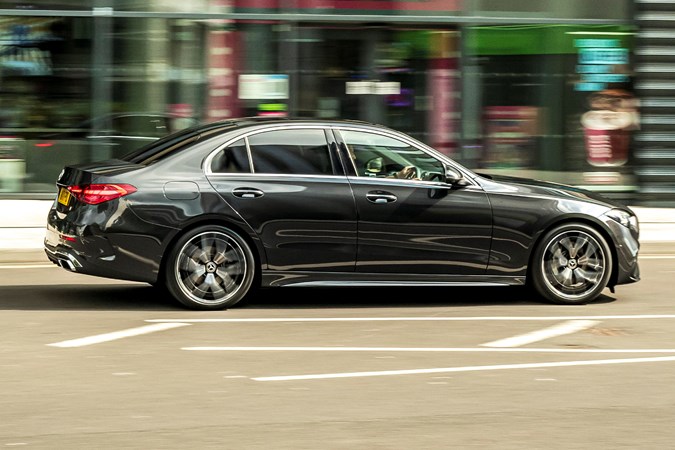
For the most part, the C-Class’s nine-speed automatic gearbox is smooth. However, it can get into a bit of a fight with the mild-hybrid system in slow-moving traffic. The problem is most noticeable at roundabouts, where you slow right down (but not quite stop) and then ask for a swift getaway.
If the mild hybrid system thinks you’re stopping, it switches off the petrol engine and lets you coast along in neutral. Then, when you hammer the throttle to exploit a gap, there’s a bit of jerkiness as the gearbox catches up and slams home a gear. The plug-in hybrid model is a little smoother as it can lean on the electric motor more at slow speeds.


